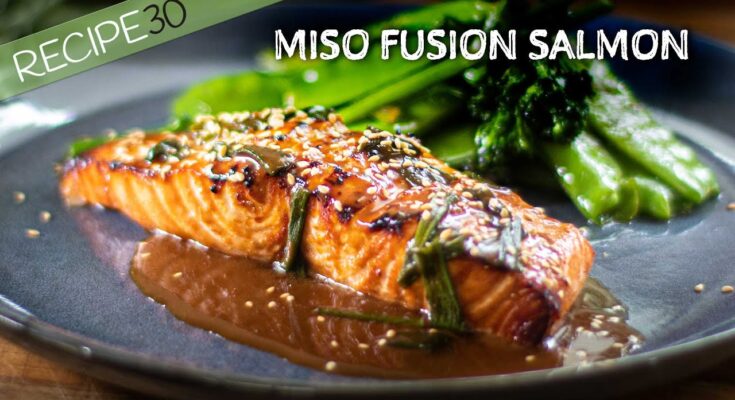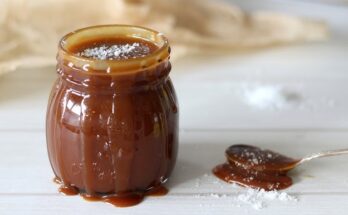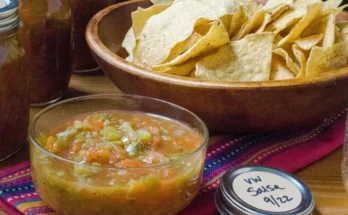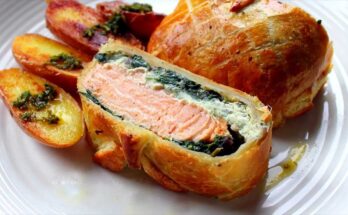Asian Salmon Recipe: If you’re a fan of bold flavors, quick meals, and healthy dishes, you’re going to love this Asian salmon recipe. This is not your average grilled fish—this is salmon that’s been infused with aromatic garlic, zesty ginger, tangy soy sauce, and a splash of honey for that sweet-savory balance that Asian cuisine is famous for.
Asian salmon has become a global favorite thanks to its explosive taste and versatility. Whether you’re making dinner for the family or impressing guests, it’s a show-stopper dish that comes together with minimal effort. It offers a perfect balance of protein, omega-3 fats, and rich flavor without being too heavy.
So why is this dish so special? It all boils down to the marinade. The fusion of traditional Asian ingredients—think soy sauce, sesame oil, ginger, and garlic—transforms a simple salmon fillet into something spectacular. In fact, once you try this, it might just become your new go-to dinner.
Let’s dive deep into every step, from selecting ingredients to serving it on your plate with style.
Ingredients You’ll Need
The success of this dish begins with the ingredients. Quality matters, especially when you’re dealing with something as flavorful and delicate as salmon.
Main Ingredients for the Marinade:
To get that signature Asian flair, here’s what you’ll need:
- Soy sauce – Provides the salty, umami base.
- Honey or brown sugar – Adds sweetness to balance the salt.
- Fresh garlic and ginger – Essential for that punchy, aromatic kick.
- Sesame oil – For nutty depth and aroma.
- Rice vinegar or lime juice – Brings acidity to brighten the flavors.
- Red pepper flakes or Sriracha – Optional, if you like a little heat.
The secret to a great marinade is balance. You want salty, sweet, sour, and spicy playing together in harmony.
Recommended Cuts and Quality of Salmon:
Always opt for fresh, wild-caught salmon if possible. It has a deeper color, richer flavor, and firmer texture than farm-raised varieties.
Choose cuts such as:
- Salmon fillets (skin-on preferred) – They hold up well in cooking and keep the flesh moist.
- Salmon steaks – Another great choice, especially for grilling.
Avoid pieces with a strong fishy smell or overly soft texture. That’s a sign the salmon is past its prime.
Prepping the Salmon
Before diving into cooking, preparation is key. This part ensures that your salmon not only tastes great but also cooks evenly.
How to Clean and Portion the Fish:
Start by rinsing the salmon gently under cold water and patting it dry with paper towels. Remove any pin bones using tweezers—trust me, nothing ruins a meal like a surprise bone.
Next, portion the salmon:
- For individual servings, aim for 6-ounce fillets.
- Keep the skin on—it acts as a natural barrier and adds crispness when cooked right.
Tips for Marinating Salmon Perfectly:
Once your fish is clean and portioned, place it in a zip-lock bag or shallow dish. Pour in the marinade, ensuring every piece is well-coated.
- Marinating time: Let it sit for at least 30 minutes, but no longer than 2 hours. Too much time and the acidic components might start “cooking” the fish.
- Refrigeration: Always marinate in the fridge to keep it safe.
Pro tip: Reserve a bit of marinade before adding the raw salmon. You can simmer it later and drizzle it over the cooked fish for extra flavor.
Cooking Methods for Asian Salmon
This dish is wonderfully flexible. You can cook it in a skillet, bake it in the oven, or grill it outdoors. Each method brings a slightly different texture and taste.
Pan-Seared Asian Salmon
This is the fastest method and gives a nice crispy skin.
- Heat a tablespoon of oil in a skillet over medium-high heat.
- Place the salmon skin-side down, pressing slightly to prevent curling.
- Cook for about 4-5 minutes per side, depending on thickness.
The goal is to get that golden crust while keeping the inside tender and juicy.
Oven-Baked Asian Salmon
Great for hands-off cooking, especially when you’re making sides at the same time.
- Preheat the oven to 400°F (200°C).
- Line a baking sheet with parchment or foil for easy cleanup.
- Bake the marinated salmon for 12-15 minutes, or until it flakes easily with a fork.
Want a caramelized glaze? Broil it for the last 2 minutes.
Grilled Asian Salmon
Perfect for summer meals and backyard vibes.
- Preheat your grill and oil the grates.
- Grill the salmon over medium heat for about 5-6 minutes per side.
- Brush with marinade or glaze as it cooks for extra flavor.
Each method is easy and quick—ideal for weeknight meals or weekend feasts.
Step-by-Step Recipe Instructions
Now that we’ve covered the prep and the methods, let’s walk through the recipe itself.
Step 1: Making the Marinade
In a bowl, whisk together:
- 1/4 cup soy sauce
- 2 tablespoons honey
- 2 teaspoons sesame oil
- 2 minced garlic cloves
- 1 tablespoon grated fresh ginger
- 1 tablespoon rice vinegar
- Optional: pinch of red pepper flakes or 1 teaspoon Sriracha
Stir until everything is well combined.
Step 2: Marinating the Salmon
Place your salmon pieces in a zip-lock bag or shallow dish. Pour the marinade over them and coat well. Let it sit in the fridge for 30 minutes to 2 hours.
Remember: too long and the acid might “cook” the salmon.
Step 3: Cooking to Perfection
Choose your method—pan-searing, baking, or grilling.
- Always preheat your pan, oven, or grill.
- Cook the salmon skin-side down first if applicable.
- Total cook time is generally 10-15 minutes, depending on thickness.
Check for doneness by gently pressing with a fork—if it flakes easily, it’s done.
Serving Suggestions
One of the best things about Asian salmon is how versatile it is when it comes to pairing it with side dishes. Whether you’re going for something light and refreshing or hearty and filling, there’s a perfect side to complement the flavors of the dish.
Best Side Dishes to Serve with Asian Salmon:
Here are some side options that match the flavor profile perfectly:
- Steamed Jasmine Rice or Brown Rice – The neutral flavor allows the boldness of the salmon to shine.
- Garlic Stir-Fried Vegetables – A mix of bell peppers, bok choy, snow peas, and carrots tossed in a light soy sauce and garlic combo.
- Asian Slaw – Crunchy cabbage, carrots, and sesame seeds dressed in a tangy sesame vinaigrette.
- Noodles – Lo mein or soba noodles tossed with veggies make a great base or side.
- Cucumber Salad – A cool, crisp side with a rice vinegar and sesame dressing to balance the salmon’s richness.
If you’re looking to keep things low-carb, cauliflower rice or a simple green salad with an Asian-style dressing are great alternatives.
Plating Ideas for Presentation:
When it comes to plating, a little attention goes a long way. Here are some easy tricks:
- Place the salmon on a bed of rice or noodles.
- Drizzle leftover (simmered) marinade or a soy-honey glaze on top.
- Garnish with sliced green onions, sesame seeds, and fresh cilantro.
- Add lemon or lime wedges on the side for an optional zesty touch.
Not only will your meal taste amazing, but it’ll look restaurant-worthy too!
Tips for Best Results
Even simple recipes come with their pitfalls. If you want to truly master this Asian salmon dish, these tips and tricks will ensure perfect results every time.
Mistakes to Avoid:
- Over-marinating – More is not always better. Too much time in a salty or acidic marinade can make the salmon mushy.
- Overcooking – Salmon continues to cook slightly even after removing from heat. Pull it off the heat just before it’s fully done.
- High heat from the start – Always preheat your pan or oven, but don’t crank it too high right away. This can burn the outside while leaving the inside raw.
- Skipping the skin – The skin not only helps hold the fish together but gets crispy and delicious when cooked right.
Storage and Reheating Tips:
If you have leftovers (lucky you!), here’s how to store and reheat:
- Storage: Place cooled salmon in an airtight container and refrigerate for up to 3 days.
- Freezing: You can freeze cooked salmon, but the texture might change slightly. Wrap it tightly in foil and place it in a freezer-safe bag for up to 2 months.
- Reheating: Gently warm it in a skillet over low heat or in a 300°F (150°C) oven. Avoid microwaving—it dries out the fish fast.
If you’re repurposing leftovers, try flaking the salmon over rice bowls or tossing it into a salad.
Variations of the Recipe
Once you’ve mastered the base Asian salmon recipe, the fun begins. There are countless ways to twist the flavors while keeping the soul of the dish intact.
Teriyaki Salmon:
This is one of the most popular variations:
- Replace honey with teriyaki sauce (or make your own by thickening soy sauce, mirin, and sugar).
- Add a splash of pineapple juice or orange zest for extra zing.
- Garnish with sesame seeds and green onions.
Teriyaki salmon is perfect for bento boxes, rice bowls, or even tacos!
Spicy Korean-Inspired Salmon:
Love heat? Go the Korean route:
- Add gochujang (Korean chili paste) to the marinade for a bold, spicy flavor.
- Include a dash of toasted sesame oil, soy sauce, brown sugar, and rice vinegar.
- Top with quick-pickled cucumbers or kimchi to balance the spice.
This version brings a fiery depth that spice lovers will adore.
Other ideas:
- Add crushed peanuts and cilantro for a Thai-inspired twist.
- Use miso paste in the marinade for a Japanese umami bomb.
The sky’s the limit, and experimenting with your favorite Asian sauces is a great way to create a custom version.
FAQs about Asian Salmon Recipe
Q1: What is Asian salmon?
Asian salmon refers to salmon fillets that are marinated or glazed with Asian-inspired ingredients like soy sauce, ginger, garlic, sesame oil, and rice vinegar, giving the dish a savory, slightly sweet, and umami-rich flavor.
Q2: Can I use frozen salmon for this recipe?
Yes, you can use frozen salmon. Just make sure to thaw it completely in the refrigerator before marinating and cooking for the best texture and flavor absorption.
Q3: How long should I marinate the salmon?
Marinate the salmon for at least 30 minutes, but no longer than 2 hours. This allows the flavors to soak in without over-tenderizing the fish.
Q4: What’s the best way to cook Asian salmon?
Asian salmon can be baked, pan-seared, grilled, or air-fried. Baking at 375°F (190°C) for 15–20 minutes is an easy and healthy method.
Q5: What side dishes go well with Asian salmon?
Asian salmon pairs perfectly with steamed rice, stir-fried vegetables, noodles, or a light Asian slaw.
Q6: Can I make this recipe gluten-free?
Yes! Just use gluten-free soy sauce or tamari to keep the dish gluten-free without compromising flavor.
Q7: How do I store leftover Asian salmon?
Store leftovers in an airtight container in the fridge for up to 3 days. Reheat gently in the microwave or oven to retain moisture.
Q8: Is this recipe suitable for meal prep?
Absolutely. You can cook a batch in advance and portion it with rice or veggies for easy, flavorful lunches throughout the week.
Conclusion
Cooking an Asian salmon dish at home doesn’t need to be intimidating or time-consuming. With the right ingredients, a flavorful marinade, and a bit of kitchen know-how, you can whip up a delicious, restaurant-quality meal in under an hour.
The magic of this recipe lies in its versatility—it’s suitable for a cozy dinner, a family gathering, or even a quick meal prep option. Once you get the hang of the flavor profile, you’ll be able to customize it endlessly to suit your tastes.
Whether you’re a novice cook or a kitchen pro, this dish delivers every time—packed with flavor, nutrition, and vibrant color. So grab some salmon, fire up your pan or oven, and dive into the rich, savory world of Asian cuisine.



